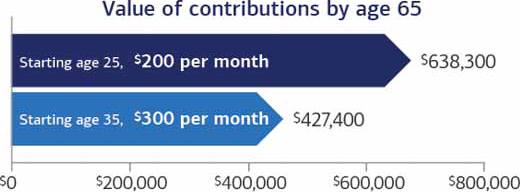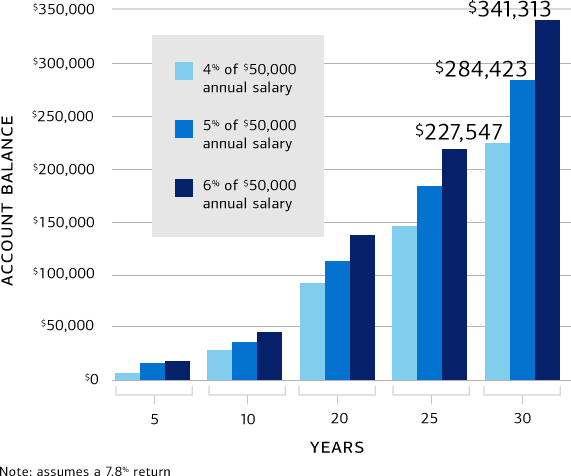Where Should I Invest My Retirement Money
10 tips to help you boost your retirement savings – whatever your age
When planning for retirement, the truth is that the earlier you start saving, the better off you could be, thanks to the power of compound interest. And even if you began saving late or have yet to begin, it's important to know that you are not alone, and there are steps you can take to increase your retirement savings. "It's never too late to get started," says Debra Greenberg, Director, Retirement and Personal Wealth Solutions, Bank of America.
Consider the following tips, which can help you boost your savings — no matter what your current stage of life — and pursue the retirement you envision.
1. Focus on starting today
Especially if you're just beginning to put money away for retirement, start saving as much as you can now, and let compound interest — the ability of your assets to generate earnings, which are reinvested to generate their own earnings — have an opportunity to work in your favor. "The earlier you can get started, the better off you'll be," Greenberg says.
Starting early may help results, even investing a small amount
By starting to put away money earlier, a 25-year-old investing $75 per month accumulates more assets by age 65 than if he or she had started to invest $100 per month at age 35 — despite investing less each period. Investing a smaller dollar amount over a long time horizon can have a greater impact on investment results than investing a larger dollar amount for a shorter period of time.

Source: ChartSource®, DST Systems, Inc. This example is hypothetical and does not represent the performance of a particular investment. Your results will vary. Actual investing includes fees and other expenses that may result in lower returns than this hypothetical example. © 2019, DST Systems, Inc. All rights reserved. Not responsible for any errors or omissions.
2. Contribute to your 401(k)
If your employer offers a traditional 401(k) plan and you are eligible, it may allow you to contribute pre-tax money, which can be a significant advantage. Say you're in the 12% tax bracket and plan to contribute $100 per pay period. Since that money comes out of your paycheck before federal income taxes are assessed, your take-home pay will drop by only $88 (plus the amount of applicable state and local income tax and Social Security and Medicare tax). That means you can invest more of your income without feeling it as much in your monthly budget.Footnote 1 If your employer offers a Roth 401(k) feature, which uses income after taxes rather than pre-tax funds, you should consider what your income tax bracket will be in retirement to help you decide whether this is the right choice for you. Even if you leave that employer, you have choices on what to do with your 401(k) account.
3. Meet your employer's match
If your employer offers to match your 401(k) plan contributions, make sure you contribute at least enough to take full advantage of the match, Greenberg says. For example, an employer may offer to match 50% of employee contributions up to 5% of your salary. That means if you earn $50,000 a year and contribute $2,500 to your retirement plan, your employer would kick in another $1,250. It's essentially free money. Don't leave it on the table.
4. Open an IRA
Consider establishing an individual retirement account (IRA) to help build your nest egg. You have two options: a Traditional IRA may be right for you depending on your income and whether you and/or your spouse have a workplace retirement plan. Contributions to a Traditional IRA may be tax-deductible and the investment earnings have the opportunity to grow tax-deferred until you make withdrawals during retirement. If you meet the phased out income limits, which are based on your federal tax filing status, a Roth IRA may be a good choice for you.Footnote 2 They are funded with after-tax contributions, so once you have turned age 59½, qualified distributions, including earnings, are federal-tax-free (and may be state-tax-free) if certain holding period requirements are satisfied. To determine what type of IRA could work best for you, go to Find out which IRA may be right for you and view the most current 401(k) and IRA contribution limits.
5. Take advantage of catch-up contributions if you are age 50 or older
One of the reasons it's important to start saving early if you can is that yearly contributions to IRAs and 401(k) plans are limited. The good news? As of the calendar year you reach age 50, you're eligible to go beyond the normal limits with catch-up contributions to IRAs and 401(k)s.Footnote 3 So if over the years, you haven't been able to save as much as you would have liked, catch-up contributions can help boost your retirement savings.
6. Automate your savings
You've probably heard the phrase "pay yourself first." Make your retirement contributions automatic each month and you'll have the opportunity to potentially grow your nest egg without having to think about it, Greenberg says. The Merrill Automated Funding Service allows you to automate regular contributions to your Merrill IRA from another account at Merrill, Bank of America or other financial institution. You can also automate your investment selection with the Merrill Automatic Investment Plan, which invests assets automatically in specific funds.Footnote 4
7. Rein in spending
Examine your budget. You might negotiate a lower rate on your car insurance or save by bringing your lunch to work instead of buying it. Merrill has a cash flow calculator that can help you determine where your money is going — and find places to reduce spending so you have more to save or invest.
Your contribution rate: a little extra can help make a big difference
How much you contribute to your retirement plan today can make a big difference in how much you have when you're ready to retire. Just increasing your contribution rate from 4% to 6% could add over $101,000 to your nest egg over 30 years, assuming a $50,000 salary.

Source: Bankrate, 401k Retirement Calculator. This example is hypothetical and does not represent the performance of a particular investment. Your results will vary. Actual investing includes fees and other expenses that may result in lower returns than this hypothetical example.
8. Set a goal
Knowing how much you may need can not only help you better understand why you're saving, but also can make it more rewarding. Set benchmarks along the way, and gain satisfaction as you pursue your retirement goal. Use the Personal Retirement Calculator to help determine at what age you may be able to retire and how much you may need to invest and save to do so.
9. Stash extra funds
Extra money? Don't just spend it. Every time you receive a raise, increase your contribution percentage. Dedicate at least half of the new money to your retirement plan. And while it may be tempting to take that tax refund or salary bonus and splurge on a new designer purse or a vacation, "don't treat those extra funds as found money," Greenberg says. She advises that you treat yourself to something small and use the rest to help make bigger leaps toward your retirement goal.
10. Consider delaying Social Security as you get closer to retirement
"This is a big one," Greenberg says. "For every year you can delay receiving a Social Security payment before you reach age 70, you can increase the amount you receive in the future." Age 62 is the earliest you can begin receiving Social Security retirement benefits, but for each year you wait (until age 70), your monthly benefit will increase, and the additional income adds up quickly. Pushing your retirement back even one year could make a significant difference.Footnote 5 It can also increase potential future survivor benefits for your spouse.
"Recognizing the need to put money away for retirement is the first step," Greenberg says. Understand how much you want to sock away for retirement, and find creative ways to increase your contributions. Starting too late and saving too little is a common regret among retirees. Making the effort now can help you look forward to retirement.
Next steps
- Find out if you're on track for retirement by using our Personal Retirement Calculator to help determine at what age you may be able to retire and how much you may need to invest and save to do so
- Determine where your money is going by using our cash flow calculator
- Learn how the Merrill Retirement Evaluator can help you see where you stand in your current retirement planning
Footnote 1 Income tax will be due upon withdrawal and you may be subject to a 10% additional federal tax for withdrawals prior to age 59½.
Footnote 2 Contributions to Roth IRAs begin to phase out at different income ranges for married taxpayers filing jointly, married taxpayers filing separately and singles or heads of households. Please see Roth IRA Contribution Limits above for specific income amounts.
Footnote 3 http://www.irs.gov/Retirement-Plans/COLA-Increases-for-Dollar-Limitations-on-Benefits-and-Contributions
Footnote 4 Please keep in mind that an automatic investment plan does not ensure a profit or protect against loss in declining markets. Such a plan involves continuous investment in securities regardless of fluctuating price levels; Investors should carefully consider their financial ability to continue their purchases through periods of fluctuating price levels.
Footnote 5 http://www.ssa.gov/retire2/delayret.htm
Merrill, its affiliates, and financial advisors do not provide legal, tax, or accounting advice. You should consult your legal and/or tax advisors before making any financial decisions.
3402891-EXP012022
Where Should I Invest My Retirement Money
Source: https://www.merrilledge.com/article/10-tips-to-help-you-boost-your-retirement-savings-whatever-your-age-ose
Posted by: logsdonprecand.blogspot.com

0 Response to "Where Should I Invest My Retirement Money"
Post a Comment